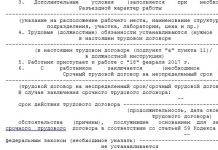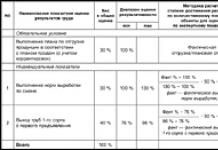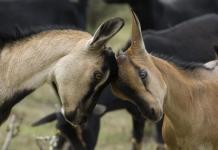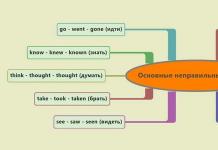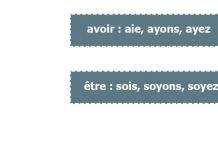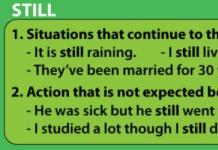Apple trees are quite hardy, grow well throughout almost the entire territory of our country and delight us with abundant harvests year after year. Therefore, it is not surprising that every amateur gardener tries to plant at least one apple tree in his garden. However, despite its unpretentiousness, it often happens that the leaves of the plant curl and then become covered with cobwebs. And if a number of measures are not taken in time, then there is a huge probability that the fruits will be affected by worms, and most of them will fall from the tree to the ground without reaching technical ripeness. What should a gardener do to help the apple tree and save the harvest?
The codling moth is the main enemy of fruit plants
If you notice that the leaves on your apple tree have curled into a tube and are covered with a network of thin cobwebs, then it’s time to sound the alarm; an apple moth has taken up residence in the garden. An inconspicuous gray butterfly, flying mainly in the evening, is the main enemy of fruit plantings. Unfortunately, it affects not only the apple tree; plums, pears and even peaches and apricots become targets for attack.
The apple codling moth appears when the surrounding air warms up to + 15 - 20 degrees, and immediately begins to multiply intensively, laying eggs on leaf blades and unripe apples. Very soon the caterpillars emerge from the clutch, and it is they who lead to the curling of the leaves and the formation of cobwebs.
Pick one affected leaf from the tree and unfold it; you will probably find a light pink caterpillar no larger than 20 mm in size. It can also be found in apples. Such fruits rarely reach technical ripeness; they usually fall to the ground. And those that do manage to ripen are greatly spoiled. They are not stored and have absolutely no marketable appearance.
How to save apple trees?
The butterfly is capable of crossing long distances, and if there are colonies of it somewhere nearby, rest assured that it will soon appear on yours. So what should you do to get rid of this harmful insect?
It is unlikely that it will be possible to defeat the codling moth without the use of chemicals, because the intensity of its reproduction is lightning fast. During the season it destroys up to 90% of the crop.
Attention! The butterfly is active in the evening, so trees should be processed in the evening in calm, dry weather.
Primary spraying of trees is carried out 3 weeks after the end of flowering. After 1.5 - 2 weeks the procedure is repeated. It’s not just the foliage that needs to be treated; the trunk and branches deserve attention—the caterpillars often live in the bark. At later stages, the use of chemicals is not recommended, since they will not have time to be neutralized and will remain in the fruit, which will not have the best effect on the nutritional properties of apples.
Attention! The codling moth caterpillars have 2 periods when they are most vulnerable: immediately after hatching from the eggs and at the time they are looking for a place to winter.
Therefore, do not be lazy, and be sure to carry out a number of preventive measures to combat the codling moth even after harvesting, when it seems that nothing threatens the tree.
For those who are committed to growing organic vegetables and fruits on their dacha farms, it is recommended to spray the trees with the following infusion:
- tansy;
- wormwood;
- burdock;
- tomato stepchildren;
- mustard.
A set of measures for pest control

It is quite difficult to dislodge a pest from your garden. Only compliance with the entire range of preventive measures will prevent leaf curling and the formation of cobwebs on trees. Watch your apple trees carefully, and then abundant harvests will be a worthy reward for your labors.
Fighting codling moth: video
Almost no garden can do without apple trees. Fruits, rich in vitamins and microelements necessary for humans, are liked by adults and children. Beautiful, covered with snow-white flowers or bending under the weight of the harvest, tree branches are a source of pride for a gardener. Therefore, it is especially offensive if cobwebs appear on apple trees; they are affected by diseases and pests.
If cobwebs appear on the apple trees, this is a sign that the trees have been attacked by pests. Most often these are different types of caterpillars. If a problem is detected, it is necessary to immediately treat the apple tree, otherwise you may be left not only without a harvest, but also lose the fruit tree. What insects can cause cobwebs to appear on an apple tree and how to fight them, this will be discussed.
Apple moth
This pest of fruit trees is known to gardeners as the ermine moth. Caterpillars are dangerous for apple trees. Their ability to protect themselves from frost with shields allows insects to survive the cold, and when temperatures above zero, pests become more active. The caterpillars intensively feed on greenery for almost a month and a half; the gnawed leaves curl and dry. And then the pest pupates in a nest formed from cobwebs.
After a couple of weeks, a small silver-white butterfly appears and lays several dozen eggs covered with a protective shield. The butterfly creates a clutch on the bark of young tree branches.
If the apple tree is not treated in a timely manner, the pest can destroy a young seedling and even an adult tree. Deprived of foliage, entangled in cobwebs, apple trees produce a depressing sight, and often do not tolerate frosty winters.
Winter moth
A brown-gray butterfly with underdeveloped wings that cannot fly is a female winter moth. The harmful insect destroys up to half the leaves on the tree, and affects fruit trees (pears, apple trees) and most other deciduous trees.
The males of this pest are light gray in color, with rounded wing edges. Butterflies of this species appear in the garden when the summer heat subsides. They can lay eggs until mid-December. They are not afraid of temperatures down to -15 °C. These insects are active in the evening and at night. The female lays eggs under the bark of trees, on branches, at the base of the buds.
The emerging bright yellowish-green caterpillars with a dark stripe on their back very quickly destroy tender buds and fresh green leaves. The caterpillars are active for a month, then they descend along the web woven in the leaves, pupate, climbing underground in the area of the tree trunk, and wait for autumn.

Gypsy moth
Butterflies belong to the moth family. Females are distinguished by a thick cylindrical abdomen and white wings. Males have light brown wings with dark patterns and a thin abdomen. Individuals are active in the evening. Males fertilize females sitting on the bark of trees, who lay a huge number of eggs on the bark. There can be up to 1000 of them in a clutch.
In the spring, caterpillars emerge from the eggs, the large bristles of which allow them to be carried over considerable distances by gusts of wind. The small caterpillar is yellow, the adult is dark, almost black. The gypsy moth destroys the buds, leaves, and flowers of the plant. The development period of the caterpillars takes 30-50 days, during which time they destroy deciduous trees over a wide area and then pupate.

Butterflies of this species are also called ringed cocoon moths. Females are much larger than males. All individuals are colored in shades of brown; depending on the region of distribution, they can be light or dark in color.
For laying eggs, the butterfly prefers young thin branches, arranging the eggs in an even ring.
The caterpillars are large, up to 5.5 centimeters in length, with bright multi-colored (white, blue, orange) stripes and bristles characteristic of silkworms. They appear during the period of swelling of the buds, destroy them and young leaves, while forming huge clumps of cobwebs.

Apple wormwood
The name psyllid that this insect has is due to the small size of the pest. It is greenish in color, with transparent wings, and about 3 millimeters long. By the end of the summer season, individuals become darker. The insect lays eggs in folds of the bark, on the bud bases. In the spring, larvae emerge from them, which, as they grow, are capable of destroying all parts of the apple tree (buds, greens, even young bark).
A small arthropod insect from the arachnid family. Individuals are up to 1 millimeter, transparent, greenish in color, becoming red or brown over time. Pests feed on plant sap. They reproduce especially actively in dry, hot weather. These pests are capable of attacking trees of different species. When spider mites spread in the garden, and the weather is favorable for them, all trees and shrubs become covered with cobwebs.

Spider aphid
This pest appears along with the spider mite. Aphids quickly attack young, succulent parts of the apple tree. It also feeds on plant sap; leaves affected by the pest first swell, changing color, and then dry out.
How to treat an apple orchard for cobwebs
Answering the question of what to do if cobwebs appear on the branches of apple trees, it should be noted that there are many effective ways to combat cobwebs in the garden. These are folk remedies used in the initial stages of infection, and complex industrial insecticides that help defeat pests in case of serious damage to the garden. Of course, each gardener decides for himself how to deal with the scourge.
Folk remedies
Folk remedies involve the use of decoctions of medicinal herbs (celandine, yarrow, dandelion, tansy) for spraying fruit trees.

Important: such products can be used every 4 weeks, the main thing is to alternate them, since pests quickly get used to them.
In addition, the plantings are sprayed with infusion of shag or onion peels. Effectively, to combat caterpillars, use a mixture of wood ash and laundry soap.
Chemicals
When choosing how to treat apple trees against pests, you should prefer complex agents that are effective against most insects. For example: Fufanon, Karbofos, Tanrek, Fitoverm. Today, biological preparations that protect against pests have appeared; they are safe and effective in use.
Bitoxibacillin
The drug is harmless to people and insects, but destroys most garden pests (adults and larvae). Use in strict accordance with the instructions.

Bicol
The biological product, classified as a bacteriological plant protection product, is effective against a huge number of garden pests (about 80) and is safe for humans.
Endobacterin
An effective product suitable for controlling most types of caterpillars and other pests of garden trees. More effective in warm weather conditions. For caterpillars and butterflies, 2 treatments are carried out with an interval of 7-10 days.

Spraying with biological preparations
Produced in warm, dry weather, in strict accordance with the manufacturer's instructions. To avoid an allergic reaction, you should wear safety glasses, gloves, and respiratory protection.
Mechanical method of combating apple moth
Methods of mechanical control of apple moth include:
- birdhouses that destroy garden pests;
- pheromone traps that lure males, preventing them from fertilizing females;
- catching belts.
Some species of wasps destroy apple moth caterpillars by laying their eggs in them.

Agrotechnical techniques
They include timely getting rid of weeds, digging up the root circle of apple trees, whitewashing the trunks and, if necessary, treating the trees with garden varnish. Timely pruning of trees also helps reduce the likelihood of pests spreading.
Timing of treatment
To protect apple trees from caterpillar invasion, trees are treated several times per season..
Before the buds open
The first treatment is carried out in the spring, when dry weather sets in and temperatures above +10-15 °C. Trees are treated with preparations of the gardener's choice. This effect allows you to destroy the larvae of caterpillars that feast on young buds.

After bud break
After the buds open, a second treatment is carried out. You can spray the trees with Bordeaux mixture or copper sulfate.
During flowering
It is better not to treat trees with insecticides during flowering. During this period, it is recommended to collect cobwebs manually.
During fruiting
If necessary, treatment is carried out with biological preparations at least three weeks before harvest. During this time, the substances become harmless.

Final processing
It is held in the fall, after the trees have shed their leaves. Trees are processed in dry, windless weather at +8-10 °C. For processing, Bordeaux mixture is used, which is easy to purchase at a garden store. The trees are treated without sparing the working solution. They also spill the soil around the apple tree to destroy the pupae.
Prevention of pest occurrence
In the spring, before the buds open, you should carefully inspect the trees. Larvae, when detected, are scraped off manually. You should dig up the apple trees and whiten not only the trunk, but also the lower branches. If cobwebs appear on the branches, they need to be collected and burned.
During the spring-summer season, you should carefully inspect fruit trees. When a web is detected, it is immediately removed and burned. In addition to all the indicated methods, the caterpillars are knocked down with jets of water when watering or shaken off onto a cloth or polyethylene spread under a tree, and then burned.
With careful attention to your own garden, timely processing and application of a set of pest control measures, the likelihood that apple trees will be seriously damaged by caterpillars and other insects is very small. In response to your care, the plants will respond with an enviable harvest.
There are fruit trees in cobwebs, with eaten leaves, next to the editorial office. What a spectacle! And this spring, it seemed to us, there were especially many such trees. At first we all decided that they had been attacked by aphids. But, having looked at a photo of aphids found on the Internet, where there was no hint of a web, they immediately dismissed the assumption made.
The BG correspondent asked the Deputy Director for Research of the Polesie Agrarian-Ecological Institute of the National Academy of Sciences of Belarus, Candidate of Biological Sciences, Associate Professor to identify the pest that has occupied cherry plum and apple trees nearby and tell us how to fight it. Victor Demyanchik. And this is what he said.
Mole is a small insect from the order of Lepidoptera butterflies, in which there are from 2 to 3 thousand species. The butterfly itself is a completely harmless creature, but it lays eggs, from which voracious caterpillars are born.
Who attacked the fruit trees?
On the trees you saw nothing more than the web bags of fruit moths. There is such a nocturnal butterfly - a moth. Everyone immediately recognizes her when she lives in apartments. But that moth eats valuable furs or food. So the moth that attacks fruit trees is a close relative of the moth that lives in the closet.
In addition to the fruit moth, there is also an apple moth. They are very similar to each other. It’s just that the fruit tree does not limit itself to apple trees; it also settles on plums, apricots, cherries, and sometimes on pears. Apple makes exactly the same bags, they differ in their larvae in appearance.

There is no sharp outbreak this season
Based on the situation this year, I can say that it only seems at first glance that there were a lot of fruit moths this spring. In terms of overall temperature, a spring like this one is rare. During winter, the insects slept off, then the weather suddenly became warmer, and they rushed to reproduce. But in fact, there is no sharp outbreak this season. What we have is the long-term average. There are too many moths if the wintering period turned out to be particularly successful for them. And if the winter is harsh, continental, not much survives. A few years ago there really were peak seasons when its quantity went off scale.

Thunderstorm of moths - sparrows and tits
Now the fruit moth is at the stage when the fed-up larvae, which look like worms, have made themselves something in the form of a protective cage from the web and taken a position in its center. There is a reason why birds are reluctant to feed on fruit moth larvae. The web clings to the beak, or more precisely, to the hairs at the beginning of the beak, irritation occurs, and this place begins to itch.
But when it rains, the web will get a little wrinkled. That’s when the field sparrow and great tit, which have already had broods, begin to work together with these guys. To deftly grab the larval worm, cunning birds try to find a hole in the web sac.
Fruit moth- a small butterfly from the moth family. Its forewings are silvery-white on top with three rows of black dots. On their leading edge there is a grayish coating. On the underside, both pairs of wings are gray-brown, with a span of about 2 cm. There are many scales in the form of hairs on the head. Distributed in most of Europe.
It’s empty to poison her with household chemicals
Against this insect, fruit plantations are usually actively treated with drugs that are not at all safe for human health. As a result, there is no talk of an environmentally friendly product. Some, out of their naivety, immediately search on the Internet for how to treat trees in the web, and run to a store where they sell household chemicals. There is no need to do this. It's empty! 
Don't be afraid of fruit moths. From the wind and rain, the web bags will fly apart and crumble. And the surviving caterpillars will turn into pupae. Then the fruit moth will fly out of them, lay eggs in different places on the tree and then die. All this is harmless from the point of view of fruiting and tree health.
Moreover, there is another plus in her appearance. In order for the optimal amount of plums, apples, cherries or pears to ripen, it is not advisable to have a lot of foliage. Experienced gardeners try to cut off excess branches before flowering begins. But many simply have no idea what anti-aging tree pruning is, and without it they run wild.
So, when the fruit moth eats the leaves, the tree, even without pruning, has the opportunity to release its juices only into the fruits. In a word, when spider sacs hang on a tree, this does not mean at all that the harvest is lost. On the contrary, it will only improve. This year there was very active flowering and active ovary. Trees don't need that much ovary. The fruit moth will eat the extra leaves and ensure normal fruit yield, and in rainy weather it will itself become food for tits and sparrows. There has never been a case of fruit moths drying out a tree. 

Growing a quality crop is not an easy task for an amateur gardener. How much work you need to put in, how much knowledge you need to gain. The most difficult thing is to learn to recognize the appearance of pests and diseases in time. Below we will discuss the question of what to do if cobwebs and caterpillars suddenly appear, and how to recognize the enemy.
How to deal with caterpillars on an apple tree in a cobweb?
The list below presents the main types of caterpillars on apple trees in the web, and tips on how to deal with each of them:
- Gray, almost black caterpillars with blue stripes on an apple tree in a web are nocturnal. This is the famous ringed silkworm. The web wraps around the branches and the pest sits in it all day without moving; at night it is active. To solve this problem, you can use tinctures of wormwood or milkweed. Spraying is carried out before the tree begins to flower. The drugs “Lepidocid” and “Bitoxibacillin” have proven themselves well. But they work effectively only if the temperature does not drop below 15°C.
- Green caterpillars on an apple tree in a cobweb paired with very roughly nibbled leaves will indicate the appearance of a winter moth. The green body is covered with one dark and three light stripes on the sides. The danger lies in the fact that the caterpillar crawls inside the bud before it opens and completely eats away the contents. And later the pest switches to the leaves and flowers of the tree. In order to fight these caterpillars on the apple tree in the web, in the fall we put hunting belts on the tree trunks. After the buds open, we treat the trees with pesticides or herbal tinctures. During the blooming period, trees can be treated with biological preparations designed specifically to combat this pest.
- Yellow caterpillars in the web on an apple tree is called apple moth. This insect damages only apple trees. You can recognize the enemy by clear black dots located in two rows along the yellow body. You can fight caterpillars on an apple tree in the web with such black dots using tobacco tincture. Tobacco tincture is prepared and used during the treatment of wood against fungus. A decoction of yarrow helps no less well. There are means for those who support the use of ready-made ones. Spraying can be combined with mechanical methods: in the spring, brown leaves are removed from the tree, the caterpillar should remain inside.
- Found on an apple tree in a caterpillar's web gray with hairs, growing from bunches. A special feature of this pest is its ability to easily move by wind from the crown of one tree to another. That is why it is important in the spring to carefully inspect all trunks and stumps where pest nests may be located. These places are scraped off with a knife and treated with kerosene. For spraying, preparations and tinctures recommended for ringed silkworms are suitable.

The danger of all these pests lies in the fact that they spread with great speed, therefore, masonry that is not detected in time is a serious threat to the garden. In addition, if tree plantings are too dense and the pest has infected at least one tree, problems cannot be avoided.
It is important to prune the garden before the growing season begins; this will help reduce the pest population. Also pay attention to the tree trunk. All wounds and hollows should not be left untreated, as this is an ideal place for laying caterpillars. Experienced gardeners do not neglect attracting birds to reduce the number. Modern biological preparations such as Entobacterin also perfectly solve the problem, while remaining completely safe for humans. However, any of the described methods will give good results provided timely intervention.
Reading time: 4 min
Caterpillars appear when butterflies lay eggs. These small caterpillars are very voracious by nature. In addition, they are unpretentious to environmental conditions. Caterpillars eat the leaves, fruits and flowers of apple trees with equal success, no matter what the weather is, and they do this from early spring to late autumn. If you don't fight them, the worms will completely destroy the apple tree.
In most cases, they are easy to detect; to do this, carefully inspect the tree. Almost all types of caterpillars are large enough to be noticed.
In our area, the most common species found are ermine moths, moths, ringed and gypsy moths, and hawthorn. The most noticeable are the silkworm larvae. The length of their shaggy body reaches seven centimeters in length.
Have questions?
Ask and receive useful advice from professional gardeners and experienced summer residents.
Hawthorn looks much more modest. This black caterpillar is smooth and very small. It's harder to notice.
Consequences from the pest

Initially, the caterpillars hide under the bark of apple trees. At this time, it is difficult to detect them. Meanwhile, they carry out their harmful activities under the bark. Caterpillars are able to gnaw channels in a tree trunk, which contributes to the appearance of fungal diseases, which are much more dangerous for apple trees.
The caterpillars cause the greatest damage when gardens are in flower. They eat buds and ovaries. Luckily, they are easiest to spot on flowers. Apple blossoms are most readily consumed by leaf rollers, codling moths and hawthorns.
It is worth saying that the leaf roller caterpillar also affects gooseberries, pears, currants and garden flowers.
How to get rid of caterpillars on an apple tree

In order to successfully fight black and any other caterpillars on an apple tree, you need to take preventive actions and determine what kind of pest is on the tree. If you find gray caterpillars, it means they are hawthorns. If a cobweb has formed on the foliage or branches, this indicates that an apple moth has appeared in the crown of the tree. The presence of leaf rollers on an apple tree causes the leaves to curl.
Preventive actions include spring whitewashing of trunks with lime mortar, timely pruning of branches, proper and regular fertilizing and, of course, watering on dry days. This work should be carried out regularly from early spring to late autumn, then caterpillars will not appear on the leaves of the apple tree.
How to fight the codling moth

The codling moth is very common in our gardens. Its pupae spend the winter in the soil near the trunks of apple trees. With the onset of spring, butterflies emerge from the pupae and lay eggs on the leaves of the apple tree. It is difficult to see them; they are extremely small. In early summer, tiny worms hatch from these eggs. These are the caterpillars of the moth. They feed on the core of the fruit, rendering it unusable. Under their influence, unripe apples fall. How to treat apple trees in June?
To successfully combat the pest, first of all, collect all fallen apples and destroy them. Adhesive catching belts, which are attached to apple tree trunks below the very first branch, have proven to be very effective.
After the apple tree has finished flowering, treat it with insecticidal preparations. This is a solution of chlorophos (0.2%) or karbofos (0.3%). Experienced gardeners first spray one tree and watch it for a day. If nothing bad happened to the apple tree, then the remaining trees are treated.
How to treat an apple tree against leaf roller caterpillars

Green caterpillars emerge from the eggs of leaf roller butterflies. They love apple buds when they are still young, then they switch to flowers, and then to leaves. The waste products of leaf roller caterpillars look like cobwebs. Under its influence, the leaves curl into tubes, inside which the caterpillar lives.
How to deal with apple tree pests? Mechanically. Tear off all curled leaves and burn. If in the spring there are too many of these pests on the tree, then before flowering, spray the apple tree with a 3% solution of nitrafen. Repeated treatment can be done no earlier than two weeks later.
Folk methods of struggle

Gardening goes back thousands of years and, of course, during this time people have come up with many folk remedies for killing caterpillars on apple trees.
Washing off the caterpillars with a tight stream of water is a fairly effective method. Of course, all caterpillars need to be collected from the ground and destroyed.
If you plant tomatoes between the rows of apple trees, the smell of their tops will repel caterpillars.
Glue belts on the trunks of apple trees will prevent the larvae from reaching the crown.
In early June, apple trees can be sprayed with a rich decoction of pine needles, celandine, tansy or burdock. Caterpillars cannot stand their smell. Two weeks after the end of flowering, it would not hurt to repeat this treatment again.
The caterpillars also do not tolerate the smell of tomato tops decoction.
A decoction of wormwood or yarrow also helps get rid of caterpillars.
No less effective methods of combating caterpillars are solutions of baking soda, vinegar or laundry soap. You can use ash instead of baking soda.
Traditional recipes have one drawback. They need to be alternated, since caterpillars are able to adapt to a specific means. You can treat apple trees with these products at intervals of one week.
Chemicals

The use of chemicals to combat caterpillars is a last resort when it is impossible to get rid of them by other means. Here we are talking about the use of poisons. Use chemicals strictly according to the instructions, which are always printed on the packaging. You need to work with them wearing protective clothing, rubber gloves and goggles. Be sure to use a respirator.
- Intavir is available in tablet or powder form. No more than three treatments per season are allowed.
- Tanrek is a systemic drug. The product has a detrimental effect on caterpillars within three weeks. It can be used only before the apple trees begin to bloom and after the harvest is completed.
- Karbofos and Fufanon. Both drugs have a contact method of influencing caterpillars. Under their influence, insects' digestive systems are paralyzed and they die of starvation. The insecticides contain malathion, which lasts ten days in the absence of rain. These products can only be used during the growing season of apple trees, no later than 3 weeks before the start of apple picking. No more than two sprayings are allowed in one season.
- Fitoverm does not contain chemical toxic substances; it is a biologically active means of combating insects. One ampoule is designed for 2.5 liters of water. You cannot spray apple trees with this product during flowering.
Prevention

- Inspect apple trees regularly to detect harmful insects and their larvae.
- In the spring, destroy all egg-laying and spider nests found on the tree, and also whiten the trunks with lime mortar
- Throughout the season, pluck and burn all the leaves rolled into a tube.
- Periodically spray the soil under apple trees with endobacterin.
- Don’t be lazy to spray apple trees with folk remedies against caterpillars.
- Place several feeders in the garden for birds that eat caterpillars.
If you follow the entire complex of the above measures, then caterpillars will not appear on your apple trees, which means that you will definitely reap a good harvest of tasty apples.









